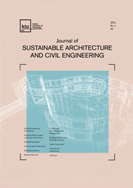Experimental and Numerical Investigation of Concrete Filled Closed Section Steel Beams
Experimental and Numerical Investigation of Concrete Filled Closed Section Steel Beams
Author(s): Deividas Martinavičius, Mindaugas Augonis, Nerijus Adamukaitis, Tadas ZingailaSubject(s): Architecture, Evaluation research
Published by: Exeley Inc.
Keywords: composite beam; confined concrete; buckling; finite element analysis;
Summary/Abstract: The aim of this paper is to investigate closed section steel and composite beams. Composite beams usually possess an increased stiffness compared to the regular steel profiles. As a consequence, vibrations of the composite beams are lower. What is more, composite beams have a relatively high fire resistance. In many cases, this kind of beams can be used without additional fire protection. Furthermore, when the concrete in the composite beam is compressed, it becomes confined by the steel profile. Confined concrete possesses a more favourable behaviour. It becomes more ductile and can reach a relatively high compressive strength. All those qualities make the usage of the composite constructions beneficial and effective. However, the theoretical evaluation of the composite beam resistance becomes complicated as there are many different models for the confined concrete. Another problem is contact between steel and concrete. It can be evaluated as a friction between different materials or a stiff connection between surfaces. In this research, experimental tests are carried out. Two steel and two composite beams are tested under bending. Load-displacement curves are obtained. Mechanical properties of the concrete are investigated. Experimental results of the beam bending are compared to those obtained by the finite element analysis. Material model of the concrete confined by the steel profile is used in the analysis. The similar finite element analysis is later carried out to investigate the beams of another author. The validity of theoretical models is investigated.
Journal: Journal of Sustainable Architecture and Civil Engineering
- Issue Year: 22/2018
- Issue No: 1
- Page Range: 88-98
- Page Count: 11
- Language: English

